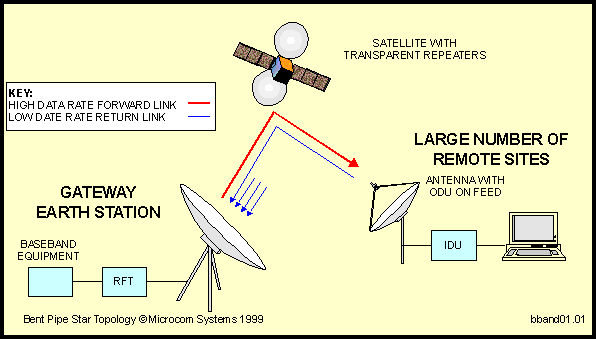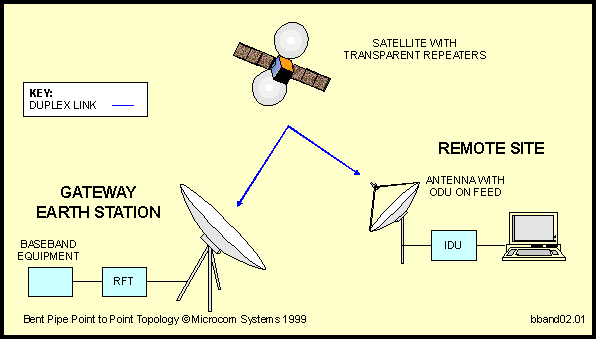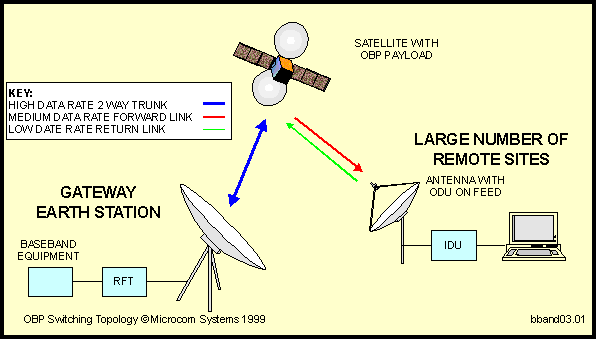|
Introduction
Typically,
broadband constellations offer high data rate connections
in the range of hundreds of kb/s to Mb/s.
These connections
are generally intended for use by very large numbers of
low priced terminals. In the long term, these systems will
make conventional VSATs obsolete.
Over a shorter
timescale, in the next few years, broadband satellite systems,
with user terminals up to an order of magnitude cheaper
than conventional VSAT terminals, will make significant
inroads into the corporate VSAT market.
Key markets
identified for broadband satellite services are:
- Internet/Intranet/Extranet
connectivity for both consumers and all categories of
business users
- interactive
TV
- dedicated
point to point connections
- shared connectivity
(short term links on demand for transaction based data)
- transport
(carrying telecommunications on a wholesale basis)
- fixed telephony
(basic services in underdeveloped regions)
Most systems
share a number of key characteristics:
- Small, very
low cost user terminals will be networked in a star topology
from large terrestrial gateway earth stations. Some systems
may support meshed networks.
- Only a small
number of gateway earth stations will be established for
each system. Generally these will be owned and operated
by key system investors.
- The satellites
may have regenerative repeaters with on board switching
and may have automatic routing between satellites using
intersatellite links.
- User terminal
characteristics will be standardised by the satellite
operator for each system.
- User terminals
for each system will be supplied by a very restricted
number of manufacturers, who generally will be key system
investors.
Of the twenty
or so systems which will attempt to enter the market before
the market stabilises in the next five to ten years, industry
analysts believe that only a few systems will survive. This
may not be the case, however, because the LEO/MEO systems
and GEO systems address different but overlapping markets.
LEO/MEO systems
are generally targeted at business users and support professional
services. They are in competition with terrestrial broadband
technologies such as fibre and xDSL. Wherever terrestrial
broadband access is available, satellite solutions will
probably not be cost effective, however, everywhere else
satellite will be the only solution. The vast majority of
the world, away from large concentrations of population
mainly in the developed world, will not have terrestrial
broadband access available for decades.
GEO systems
are also targeted at business users, however there is a
very large potential consumer market for interactive services,
particularly Internet type services and interactive TV,
which is not currently addressed by any service provider.
This market will slowly begin to grow over the next few
years and may eventually become the norm, virtually replacing
broadcasting as we currently know it. Again, satellites
will have a significant place in this market wherever a
terrestrial option is not available or is not packaged by
broadcasters as well as equivalent or better satellite products.
Several conclusions
are forced from the market background above which will have
a profound impact on the satellite service industry as a
whole:
- The broadband
satellite market will experience an extreme level of competition
which will probably result in a price war starting perhaps
in 2002 or 2003, just as most systems are beginning to
establish operations.
- Although
Ka band terminal technology is relatively expensive today,
it will rapidly become as cheap as current consumer satellite
TV technology. Economies of scale may well make Ka band
SSPAs considerably cheaper than corresponding Ku band
products - today the Ku band SSPA market is of the order
of tens of thousands per year, within five to ten years
the Ka band SSPA market could be tens of millions of units
per year from domestic consumers alone.
- This competition
will have a severe knock on effect on the conventional
VSAT market which will face severe price competition.
Unless existing equipment and service suppliers can reduce
their prices significantly (by anything up to a factor
of 10) they will not be able to survive.
- Investing
gateway operators and user terminal suppliers in the failed
broadband systems will each face losses in the range of
several ten to several hundreds of millions of US$. Many
of these will face bankruptcy or will become take-over
targets.
- Competition
in the satellite service industry will be severely restricted
from about 2005 because of existing suppliers leaving
the market or being absorbed by other suppliers.
|
| GEO Broadband Satellite Systems
Most broadband satellite systems
consist of high power GEO satellites. These are really extensions
of current DBS/DTH technology into interactive TV, multimedia
and Internet access.
The potential domestic and
small business market for the services offered by these
systems is very large. GEO broadband systems will make inroads
into the television market providing a spread of consumer
packaged products including conventional broadcasts, interactive
TV (game shows, gambling, talk shows, home shopping), interactive
services (banking, shopping, e-commerce, education, information
services, database access) and Internet access.
The interactive services and
Internet access will be particularly interesting for business
users.
GEO broadband satellite systems
will be capable of replacing conventional VSATs for many
applications. As far as the end user is concerned, instead
of using a dedicated hub or leasing space on a shared hub
from a service provider, capacity will be leased from a
convenient gateway operator. Whilst this will offer a certain
economy of scale, a single gateway operator will replace
perhaps dozens of conventional VSAT service operators reducing
user choice.
User choice will be further
reduced because it will become much more difficult for a
large corporation to operate its own network as is done
by many organisations at present. In many countries the
only financially sensible route for large corporations looking
for a satellite solution will be to lease gateway and space
segment capacity through a regional gateway operator.
GEO gateway earth stations
will be owned by the systems operator or by a regional franchisee.
Gateway costs will probably be of the order of 10 MEuro
plus. |
|
|
|
GEO Broadband User Terminals
In many ways
user terminals will be similar
in operation and appearance to existing satellite terminals:
Interactive consumer terminals
will be similar to current domestic satellite TV set top
boxes and will be attached to a small dish mounted outside
the house, typically on an external wall. The main differences
between a broadband terminal and a current DTH/DBS system
will be that the broadband terminal will also have a small
SSPA integrated with the antenna feed assembly giving
a transmit capability and the set top box will have some
form of keyboard or mouse, possibly connected by an infra
red link.
Business terminals will be
practically indistinguishable from current VSAT remote
terminals, though the antennas will generally be smaller
than is usual today. Business terminal costs will be considerably
lower than conventional VSAT terminal costs and will generally
be in the range 750 to 2,000 Euro depending on performance
and supplier. |
| LEO/MEO Broadband Satellite Systems
A few broadband systems consist
of large constellations of LEO/MEO satellites. These will
be sophisticated orbiting networks with ISLs (intersatellite
links) to other satellites in the constellation. The constellations
will be very large, sometimes numbering hundreds of satellites,
with adjacent satellites interlinked by a complex mesh
of optical or Ka band intersatellite links.
Broadband LEO/MEO constellations
require complex and very expensive tracking gateway earth
stations which are capable of maintaining contact with
several satellites at any time as they track across the
sky in a few minutes. Gateways will be owned by the systems
operator or a regional franchisee and will cost of the
order of 50 MEuro plus.
The potential business market
for services is large but, being business oriented, is
still very small compared to the potential consumer market
available to GEO broadband systems. These systems are
in direct competition with conventional VSATs, offering
all the services that VSATs currently offer and more. |
| LEO/MEO
Broadband User Terminals
LEO broadband user terminals
will be considerably more complex than GEO terminals.
The main reason for this is the necessity to track the
rapidly moving satellites as they traverse the sky. User
terminals must therefore be equipped with antennas that
can lock onto a satellite and that can rapidly acquire
another satellite as the satellite being used for communications
passes out of view. Most systems intend to use a planar
array antenna with electronic beam forming and pointing.
Skybridge, however, appears to intend to use a mechanically
tracked dish in a small radome as its baseline. Tracking
also requires a relatively sophisticated antenna controller.
LEO systems also suffer from
significant Doppler shifts which must be allowed for in
both the terminals and the gateway earth stations. Whilst
this is not a major problem in the gateway earth stations,
the sophisticated Doppler control is a further major burden
in the user terminals which adds a further level of complexity
and therefore cost.
At the moment it is not clear
whether it will be possible for the terminal manufacturers
to meet their cost targets as well as the stringent performance
requirements that are imposed by the use of LEO satellites. |
| Network
Topologies
Irrespective of the type
of orbit used, there are three main network topologies
used for broadband systems. The type of orbit only affects
the complexity of the physical implementation. The topology
is, however, dependent on whether the satellite payload
used has an on board processing and switching capability
or is transparent.
Two network topologies are
applicable to transparent payloads:
- bent pipe star topology
- bent pipe point top point
topology
whilst one topology will
be used for on board processing (OBP) payloads:
|
| Satellite
Broadband Technology
Revolutionizes
Internet Services and Usage.
A
satellite 2 way Internet platform can reach speeds up
to three times faster than a dedicated ISDN line. |
| Today
information plays a critical role in how we work, interact
and even enjoy our free time. But the speed at which we
obtain that information can often pose a problem. Until
now, a large file or document could take hours to transmit,
tying up important computer resources. With
the emergence of satellite broadband it is now possible
to download large files and seconds instead of minutes
and access worlds of information rapidly with advanced
satellite technology. Rather than crowded computer networks
and outmoded telephone systems that are constantly flooded
or clogged.
These systems offer the advantage
of downloading content from the Internet directly from
the server to a satellite network and straight to the
PC. A constant stream of content to a single dish capable
of delivering both 400 kbps of data and channels
of digital satellite television if desired. All
of this comes into the home or office through a single
satellite dish.
A satellite
2 way Internet platform can reach speeds up to
three times faster than a dedicated ISDN line.
| ISDN provides
you with two 64 Kbps channels for a total capacity
of 128 Kbps. Then you have to pay the phone company
an installation fee, monthly charges, applicable per-minute
charges, and the cost of a modem. In addition you
will pay a higher ISP access charge.
ISDN pricing also varies
widely - depending on your location - with remote
locations paying a premium. Satellite Internet
offers a faster and less expensive alternative to
ISDN. |
|
|
The
satellite solution is largely about accessibility. The
satellite industry offers broadband access for homes and businesses
that are inaccessible to cable modems and DSL connections.
Using a telephone modem backchannel, Internet
surfing via satellite has been available for several years. In late
2000, two-way broadband satellite services became available. The maximum
speed advertised is 400 Kbps, but with shared networks the average data
throughput may be less.
Developing a network in the sky has advantages
beyond simple availability. When the shared network is bogged down,
the satellite provider may arrange to use another transponder at the
same orbital location. New satellites are launched when existing transponder
capacity is saturated.
With the emergence of the next generation
of KA-band satellites and spot-beam technology, satellite will provide
speeds over 1 Mbps. Since satellite is the only option for many, it
is expected that by the end of 2005, over 9 million homes worldwide
will access the Internet via satellite.
Orbits
Three different orbits are proposed for
these new broadband services: LEO, MEO and GEO.
| Comparison
Between LEO, MEO and GEO |
| Orbit type |
Low
Earth Orbit (LEO) |
Medium
Earth Orbit (MEO) |
Geostationary
Earth Orbit (GEO) |
| Orbit
Characteristics |
|
|
|
| Altitude
(km) |
700 to 1400 |
10,000 to 15,000 |
36,000 |
| Satellites
Needed For Global Coverage |
40 + |
10 to 15 |
3 to 4 (1) |
| Phased
Start Up Possible |
No
(global coverage)
Yes (if phase start up region by region) |
Yes |
Yes |
| Link
Characteristics |
|
|
|
| Delay |
0.05 s |
0.10 s |
0.25 s |
| Elevation
Angle |
Low |
Medium to High |
Low to Medium |
| Call
Handover |
Frequent |
Infrequent |
Never |
| Operations |
Complex |
Medium |
Simple |
| Building
Penetration |
Poor |
Poor |
None |
| Satellite
Characteristics |
|
|
|
| Space
Segment Cost |
High |
Low |
Medium |
| Satellite
Lifetime (years) |
3 to 7 |
10 to 15 |
10 to 15 |
| Telephony
Network Characteristics |
|
|
|
| Terrestrial
Gateway Costs |
High |
Medium |
Low |
| Hand
Held Terminal Possible |
Yes |
Yes |
Yes |
| Hand
Held Terminal Costs |
Low |
Low |
Low |
| Mobile
Terminal Costs |
|
|
Medium |
| Fixed
Terminal Costs |
Low |
Low |
Low to Medium |
| Data
Network Characteristics |
|
|
|
| Store
and Forward Possible |
Yes |
Not Required |
Not Required |
| Point
to Point Connections Possible |
No |
No |
Yes |
| VSATs
Possible |
Yes (2) |
Yes (2) |
Yes (3) |
| TV
Network Characteristics |
|
|
|
| Broadcast
TV Possible |
No |
No |
Yes |
| SNG
Possible |
Yes |
Yes |
Yes |
Notes: |
(1) |
Coverage only extends to latitudes of 70° N and 70° S. |
| |
(2) |
Via a regional gateway. |
| |
(3) |
Private and shared hubs possible. |
Bent
Pipe Star Topology
This is an evolution of the interactive
hubbed VSAT concept, though some operators will have reached this point
by adding a return path to a high data rate broadcast from a large uplink
station.
This topology is characterised by having
a large gateway earth station which transmits one or more high data
rate forward link broadcasts to a large number of small user terminals.
These broadcasts contain address information which allows each user
terminal to select those transmissions intended for it.
In the return direction, the remote user
terminals transmit in bursts at low to medium data rates to the gateway.

Bent Pipe Star Topology
Bent
Pipe Point to Point Topology
This is a development of the point to point
VSAT concept.
In this topology a dedicated two way connection
is set up between a large gateway earth station and a single user terminal.

Bent Pipe Point to Point
Topology
OBP
Switching Topology
This topology has the satellite being the
focus of a star network instead of a gateway earth station.
The satellite is connected to the gateway
earth station by one or more high data rate trunks.
In the satellite the On Board Processor
(OBP) in the payload demultiplexes the uplinked trunk and splits it
into downlinks intended for particular geographical areas (usually cells
determined by the antenna coverage pattern). The forward downlinks produced
in this fashion contain messages for large numbers of user terminals
in which the destination terminal is identified by headers in the messages.
In the return direction the uplinked transmissions
from user terminals in one or more cells are multiplexed together onto
a downlink trunk for transmission to the gateway.

OBP Switching Topology
Broadband Internet
|

